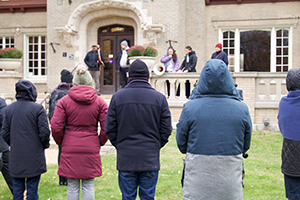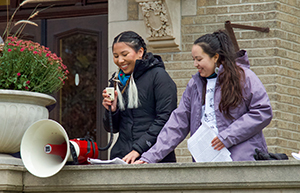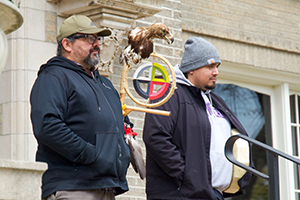Sand Creek Massacre Commemoration Creates a Space for Healing & Education
Content warning: This story contains mentions of murder and anti-Indigenous violence
On Nov. 17, a group gathered outside the John Evans Alumni Center for a procession through the Northwestern University campus to commemorate the lost lives of Cheyenne and Arapaho people during the Sand Creek Massacre.
 As frigid winds rushed through the crowd, an opening song and speech marked the start of this time of remembrance hosted by Multicultural Student Affairs (MSA), Native American and Indigenous Student Alliance (NAISA) and the Office of Institutional Diversity and Inclusion (OIDI).
As frigid winds rushed through the crowd, an opening song and speech marked the start of this time of remembrance hosted by Multicultural Student Affairs (MSA), Native American and Indigenous Student Alliance (NAISA) and the Office of Institutional Diversity and Inclusion (OIDI).
Nearly 158 years prior on Nov. 29, 1864, the Cheyenne and Arapaho awoke to a similarly cold autumn morning at Sand Creek, a dry riverbed in the southeast area of the Colorado Territory. The encampment turned into a scene of mass murder committed by U.S. soldiers, who murdered over 200 Cheyenne and Arapaho people. The massacre was carried out when John Evans, a founder of Northwestern University, and the namesake of the city of Evanston, was governor and superintendent of Indian Affairs of Colorado.
Aaron Golding, associate director of MSA and member of the Seneca Nation, spoke to attendees before the procession, encouraging them to consider the lost souls from the massacre.
“You are all our relatives. We are all related,” Golding said. “We ask that today, as you walk through campus, you think about our Cheyenne and Arapaho relatives as you would your familial relatives, that you hold them in your hearts as we move through campus. Think about how they had to flee Sand Creek on the morning of November 29.”
 The commemoration event took place during 30 Days of Indigenous, a month-long program hosted by MSA, OIDI and the Center for Native American and Indigenous Research in honor of Native American and Indigenous Heritage Month. Centered around the theme of being a good relative, 30 Days of Indigenous invited members of the Northwestern community to attend events and consider different books, recipes, films and music that celebrate Native American and Indigenous life.
The commemoration event took place during 30 Days of Indigenous, a month-long program hosted by MSA, OIDI and the Center for Native American and Indigenous Research in honor of Native American and Indigenous Heritage Month. Centered around the theme of being a good relative, 30 Days of Indigenous invited members of the Northwestern community to attend events and consider different books, recipes, films and music that celebrate Native American and Indigenous life.
SESP second year and NAISA co-Chair Athena GoingSnake, who is a citizen of the Cherokee Nation and is also Muscogee Creek, said this theme of connectedness was central to creating space for healing and reflection during the procession.
“Indigenous people have this belief that we're all related somehow,” GoingSnake said. “If one person is suffering, everyone is suffering. It’s important the community is being brought together so people affected by Sand Creek know other Indigenous people are standing with them.”
 The procession was also an invitation for the Northwestern community to learn about and contend with the University’s ties to the Sand Creek Massacre.
The procession was also an invitation for the Northwestern community to learn about and contend with the University’s ties to the Sand Creek Massacre.
OIDI’s Director of Native American and Indigenous Affairs Jasmine Gurneau, who is Oneida and Menominee, said the University has a responsibility for healing efforts with the Cheyenne and Arapaho people as an educational institution founded by Evans.
“We have an obligation to this community,” Gurneau said. “Understanding John Evans’ true role in facilitating and creating a hostile, volatile environment where it led to this massacre—when you really come to terms with that, it changes how you approach this work.”
Second-year SESP student and NAISA member Alivia Britton, who is Odawa—a part of the Little River Band of Ottawa Indians, said it is crucial to recognize the lasting impacts of the Sand Creek Massacre.
“If you ignore these parts of history, they're only going to repeat themselves in another manner,” Britton said. “Indigenous people—we’re often thought of as something from the past, but we're still here. Healing is crucial to lessen that burden that a lot of us feel with the trauma that's been endured by ancestors.”
The crowd made a stop at the Rock, where a statement addressing the massacre by the Northern Arapaho Tribe and the executive order in 2021 to rescind Evans' 1864 proclamation were read aloud. As the procession concluded, attendees gathered inside Parkes Hall to warm up and hear final remarks.
“This is part of our collective history, and it’s a weight a lot of us put on every November and carry with us,” Golding said. “I know it can be very heavy and sad to revisit this every year. It feels good to be sharing that with a lot of you.”
Britton expressed her appreciation for the community that came together as part of the commemoration.
“We're a small community, but we're mighty,” she said.
For more information on Northwestern’s Native American and indigenous initiatives, visit northwestern.edu/native.
